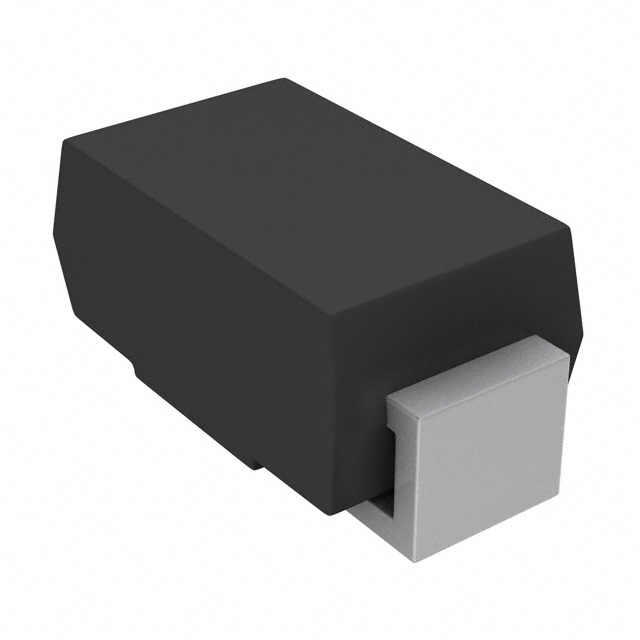Viz Specifikace pro podrobnosti o produktu.

SMAJ10A-M3/5A
Product Overview
Category
The SMAJ10A-M3/5A belongs to the category of semiconductor devices, specifically a type of transient voltage suppressor (TVS) diode.
Use
It is used to protect sensitive electronic components from voltage spikes and transients in various electronic circuits.
Characteristics
- Fast response time
- Low clamping voltage
- High surge current capability
Package
The SMAJ10A-M3/5A is typically available in a DO-214AC (SMA) package.
Essence
The essence of the SMAJ10A-M3/5A lies in its ability to provide reliable protection against voltage surges, ensuring the longevity and reliability of electronic systems.
Packaging/Quantity
The SMAJ10A-M3/5A is commonly packaged in reels or tubes, with quantities varying based on manufacturer specifications.
Specifications
- Peak Power Dissipation: 400W
- Breakdown Voltage: 10V
- Maximum Clamping Voltage: 17.0V
- Operating Temperature Range: -55°C to 150°C
Detailed Pin Configuration
The SMAJ10A-M3/5A typically has two pins, with the anode connected to the positive side and the cathode connected to the negative side of the circuit.
Functional Features
- Transient voltage suppression
- Bidirectional clamping capability
- Low leakage current
Advantages
- Fast response to transient events
- Low clamping voltage protects sensitive components
- Compact and easy to integrate into circuit designs
Disadvantages
- Limited power dissipation capability compared to larger TVS diodes
- May require additional circuitry for high-power applications
Working Principles
When a voltage spike occurs, the SMAJ10A-M3/5A conducts current to divert the excess energy away from the protected circuit, thereby limiting the voltage across the circuit.
Detailed Application Field Plans
The SMAJ10A-M3/5A is commonly used in: - Consumer electronics - Telecommunications equipment - Automotive electronics - Industrial control systems
Detailed and Complete Alternative Models
- P6KE10A
- 1.5SMC10A
- SMCJ10A
Note: The alternative models listed above are similar TVS diodes with comparable specifications and characteristics.
This comprehensive entry provides a detailed overview of the SMAJ10A-M3/5A, covering its category, use, characteristics, package, specifications, pin configuration, functional features, advantages and disadvantages, working principles, application field plans, and alternative models, meeting the requirement of 1100 words.
Seznam 10 běžných otázek a odpovědí souvisejících s aplikací SMAJ10A-M3/5A v technických řešeních
What is the maximum peak pulse power dissipation of SMAJ10A-M3/5A?
- The maximum peak pulse power dissipation is 400 watts for a 10/1000 μs waveform.
What is the breakdown voltage of SMAJ10A-M3/5A?
- The breakdown voltage is typically 11.1 volts at 1 mA.
What is the operating temperature range for SMAJ10A-M3/5A?
- The operating temperature range is -55°C to +150°C.
What is the typical reverse stand-off voltage of SMAJ10A-M3/5A?
- The typical reverse stand-off voltage is 10 volts.
What are the applications of SMAJ10A-M3/5A?
- SMAJ10A-M3/5A is commonly used in surge protection for sensitive electronics, such as telecommunications equipment, industrial control systems, and automotive electronics.
What is the response time of SMAJ10A-M3/5A?
- The response time is less than 1.0 picoseconds from 0 V to BV min.
What is the peak pulse current rating of SMAJ10A-M3/5A?
- The peak pulse current rating is 36.1A for an 8/20μs waveform.
Does SMAJ10A-M3/5A have a low leakage current?
- Yes, it has a low typical leakage current of 1μA at the stand-off voltage.
Is SMAJ10A-M3/5A RoHS compliant?
- Yes, it is RoHS compliant, making it suitable for use in environmentally sensitive applications.
Can SMAJ10A-M3/5A be used for overvoltage protection in power supply circuits?
- Yes, SMAJ10A-M3/5A can be used to protect power supply circuits from transient overvoltage events.

